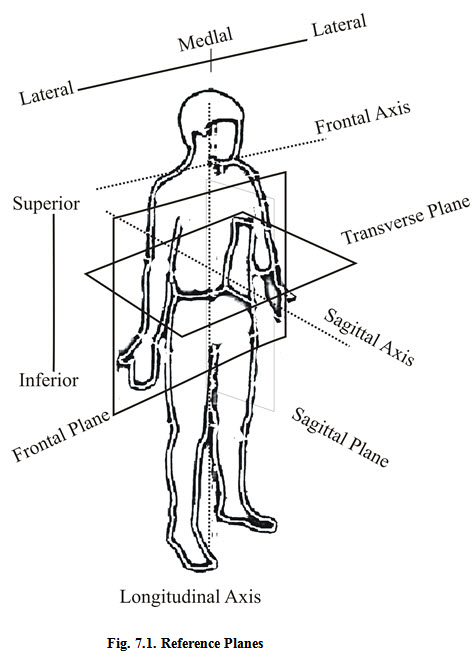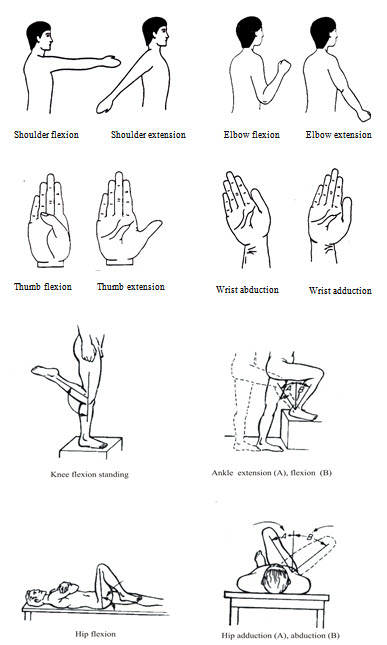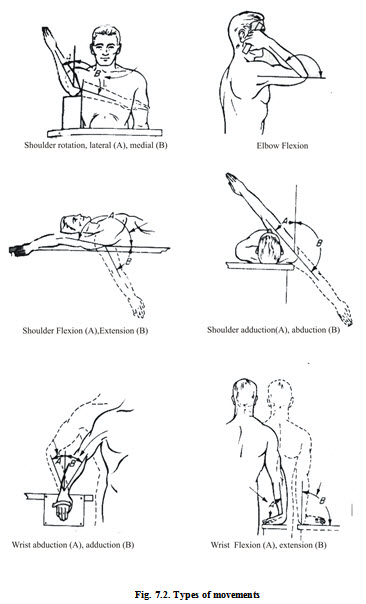Site pages
Current course
Participants
General
Module 1. Introduction to human engineering
Module 2. Human performance and responses
Module 3. Working environment and work space design
Module 4. Rehabilitation scheme and DMR Act
Topic 5
Topic 6
Topic 7
Topic 8
Topic 9
Topic 10
Lesson 7. BIOMECHANICS
7.1 Biomechanics:
Biomechanics is the study of conditions, which deals with the internal and external forces and their effects on human body. This is the study of two states of conditions viz. statics and dynamics under which subject is in motion or stay in rest. Statics condition deals largely with the conditions under which the subject remains at rest whereas dynamics condition deals largely with the conditions under which the subject moves.
7.2 Biomechanics of Human movement:
There are various tasks which require movement of the whole body, while exerting a force. Such movements can cause mechanical stresses resulting to body aches and pains. Movements can also be stressful in the energetic sense for the muscles, lungs and heart. Fundamentally there are two different approaches to studying the biomechanics of human movement: forward dynamics and inverse dynamics. Either can be used to determine joint kinetics e.g., estimate joint moments during movements.
7.2.1. Forward Dynamics
To study of human movements, the input to the system is the neural command is forward dynamics which specifies the level of activation to the muscles. The neural command can be estimated from electromyograms (EMGs) or by optimization models derived by Zajac, 1989; Pandy and Zajac, 1991. In each musculotendonous unit, the force contributes toward the total moment about the joint. Since muscle force is dependent upon muscle length, there is feedback between joint angle and musculotendon dynamics. The moment arms of muscles are not constant values, it change as a function of joint angles.
7.2.3. Inverse Dynamics
The Inverse dynamics approaches the problem from the opposite end by measuring position and the external forces acting on the body. In gait analysis, for example, the position of tracking targets attached to the segments can be recorded by using a camera-based system and the external forces can be recorded by using a force platform.
7.3 Biomechanics of Motion:
The biomechanics of motion deals with the various aspects of the physical movements of the body members. The operation of the body members can be characterized in terms of estimating the joint moments during movements (Table7.1). The bones connected at their joints, in combination with their associated muscles, of serve as lever.
Table. 7.1. Biomechanics terminology and their description
S.No. |
Terminology |
Description |
1. |
Anterior |
Anterior refers to front side, nearer the front surface of the body |
2. |
Posterior |
Posterior refers to back side, nearer the back surface of the body |
3. |
Superior |
Superior refers to the upper or higher part of body, or nearer he crown of the head |
4. |
Inferior |
Inferior refers to the lower part of the body, or nearer the soles of the feet |
5. |
Medial |
Medial is nearer the median plane of the body (or body part) which divides the body (or body part) into right and left halves |
6. |
Lateral |
Lateral refers to the farther from the median plane |
7. |
Proximal |
Proximal is the end of a body member nearer the body |
8. |
Distal |
Distal is the end of a body segment farther from the body |
9. |
Palmar or volar |
Palmar/ volar refers to the anterior surface of the hand or forearm |
10. |
Dorsal |
Dorsal pertaining to back side, nearer the back to the hand, forearm and foot (dorsal surface of the hand, opposite of palmar) |
11. |
Planter |
Planter refers to the sole of the foot |
7.4 Range of Movements:
Movement is defined by reference to a plane or axis. As Shown in Fig. 7.1. there are three planes and four axis which are described as under:
Planes of movements
Sagittal Plane - a vertical plane which passes from front to rear dividing the body into right and left sections
Frontal or lateral Plane - which passes from side to side at right angles to the sagittal plane which divide the body into a front and back section, It is any vertical plane perpendicular to the median plane which divides the body into anterior (front) and posterior (back) portion.

Transverse or horizontal Plane - a horizontal plane which divides the body into superior (upper) and inferior (lower) parts.
Axis of movements
Frontal Axis - passes from side to side at right angles to the sagittal plane
Sagittal or Transverse Axis - passes horizontally from front to rear lying at right angles to the frontal plane
Longitudinal or Vertical Axis - passes from head to foot at right angles to the transverse plane.
7.5 Types of movements of body members:
The movements which the arms, legs and other body members are capable of performing can be considered as basic are gliding and angular movements. Gliding is the simplest type of motion which exists between two adjacent surfaces. It is one surface moving over another without any rotary or angular motion. Angular motion decreases or increases the angle between two adjoining bones. The common types of angular motion and their description are described in Table.7.2
Table. 7.2. The common types of angular motion and their description:
|
S.No. |
Terminology |
Description |
|
Flexion |
Bending parts at a joint so that the angle between them decreases and the parts come closer together i.e. bending the arm or leg. |
|
|
Extension |
Straightening parts at a joint so that the angle between them increases and the parts move farther apart i.e. straightening or unbending the forearm, leg, or fingers. |
|
|
Dorsiflexion/ Plantar flexion |
Movement at the ankle that brings the foot farther from the shin i.e. walking or standing on toes. |
|
|
Abduction |
Moving a part away from the midline i.e. lifting the upper limb horizontally to form a right angle with the side of the body. |
|
|
Adduction |
Moving a part toward the midline i.e. returning the upper limb from the horizontal position to the side of the body. |
|
|
Hyperextension |
Extension of the parts at a joint beyond the anatomical position i.e. bending the head back beyond the upright position. This is generally used to describe an abnormal extension beyond the normal range of motion resulting in injury. |
|
|
Medial Rotation |
Turning toward the mid line of the body. i.e. twisting the head from side to side. |
|
|
Lateral rotation |
Turning away from the mid line of the body |
|
|
Circumduction |
Moving a part so that its end follows a circular path i.e. moving a finger in a circular motion without the hand. |
|
|
Rotation |
Movement of bone around its long axis, such as the rotation of the humerus in the upper arm. |
|
|
Pronation |
Turning the hand so that the palm is downward or facing posteriorly i.e. in anatomical position. |
|
|
Supination |
Turning the hand so that the palm is upward or facing anteriorly i.e. in anatomical position. |
|
|
Eversion |
Turning the foot so the plantar surfaces faces laterally. |
|
|
Inversion |
Turning the foot so the plantar surfaces faces medially. |
|
|
Retraction |
Moving a part backward i.e. pulling the head backward. |
|
|
Protraction |
Moving a part forward i.e. thrusting the head forward. |
|
|
Elevation |
Raising a part i.e. shrugging the shoulders. |
|
|
Depression |
Lowering a part i.e. drooping the shoulders. |


There are more operational terms of the body parts with respect to the performance of specific activities of work. These movements can be classified as below:
Positioning Movements: Positioning movements are these in which the hand or foot moves from one specific position to another, as in searching the control knob. The time and accuracy of such movements can be influenced by such factors as the nature of the stimulus that triggeres the movement, the distance and the direction of the movement.
Continuous movements: Continuous movements are those which require muscular control adjustments of some type during the movement, as in operating the steering wheel of a car or guiding a pieces of wood through a band saw.
Manipulative movements: The manipulative movements involves the handling of parts, tools, control mechanism etc. typically with the fingers or hands.
Repetitive movements: Repetitive movements are those in which the same movement is repeated as in hammering, operating a screw driver and turning a hand wheel.
Sequential movements: Sequential movements are several relatively separated independent movements in sequences.
Static adjustment: It is the absence of a movement, consistency of maintaining a specific position of a body members for a period of time. Various types of movements may be combined in sequence so that they blend one in to another.
7.6. Precautions to be taken during work movement
i) Body joints must be in a neutral position
While maintaining a posture or making a movement, the joints should be kept as far as possible in a neutral position because the muscles and ligaments which span the joints are stretched to the least possible extent and subjected to less stress. Beside this, the muscles are able to deliver their greatest force when the joints are in the neutral position. Raised arms, bent wrists, bent neck and turned head, bent and twisted trunk are examples of poor postures where the joints are not in a neutral position e.g. raised arms, bending posture etc.
ii) Always keep the work close to the body
If the work is not close and far from the body, the arms become outstretched and the trunk bent over forwards. The weight of the arms, head, trunk and also the weight of any load being held, exerts a greater horizontal leverage on the joints under stress i.e. shoulder, back, elbow etc. when the arms are outstretched, it increases the stress on muscles and joints
iii) Avoid bending forward
Continuous bending for long periods must be avoided wherever possible. The weight of upper part of the body is generally higher than the lower part. The further the trunk is bent forwards, the harder it is for the muscles and ligaments of the back to maintain the balance of upper body. The stress is particularly large in the lower back.
iv) Avoid twisted trunk
The posture of the twisted trunk must be avoided. Twisted postures of the trunk can cause stress to the spine. The elastic discs between the vertebrae are stretched, and the joints and muscles on both sides of the spine are subjected to asymmetric stress.
v) Avoid sudden movements
The sudden movements and forces must be avoided, it can cause acute back pain in the lower back and can produce large/short duration stresses. These peak stresses are a consequence of the acceleration in the movement. Lifting must occur as far as possible in an even and gradual manner. Proper preparation of lifting large force should be done in even and gradual manner.
vi) Avoid prolonged postures and repetitive movements
Always avoid prolonged postures and repetitive for a long period of time which involve regular lifting or repetitive arm movements. These posture and movements are tiring, and can cause to injuries to the muscles and joints. The ill effects of prolonged postures and repetitive movements can be prevented by alternating tasks, i.e. standing, sitting and walking should also be alternated.
References
Kurt T. Manal and Thomas S. Buchanan. Biomechanics of human movement. In Standard handbook of biomedical engineering and design. McGraw-Hill. (www.digitalengineeringlibrary.com)
Zajac, F. E. (1989). “Muscle and tendon: properties, models, scaling and application to the biomechanics of motor control,” in
Pandy, M. G., and Zajac, F. E. (1991). “Optimal muscular coordination strategies for jumping,” J. Biomech., 24:1–10.